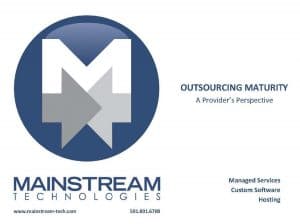A Provider’s Perspective
Outsourcing is a valuable approach for any administration team that extends beyond cost-cutting measures. If it’s approached properly, outsourcing can address both cost pressures and be used as a way to build competitive advantages.
Outsourcing is defined as any task which could be performed by a staff member(s) but is contracted to a third party for an extended period of time.
Outsource Maturity (OM) is defined as how an organization is positioned with internal processes to take advantage of the benefits of outsourcing.
There are three primary objectives for outsourcing, all of which lend themselves to the goal of creating bottom-line business benefits[4] for the organization and a win for the provider. These are:
- generating cost savings by delegating activities to a provider,
- adding access to skills to the organization which may be absent or scarce,
- identifying business advantages, efficiencies, and opportunities to increase productivity within the organization.
Outsourcing Maturity
To properly evaluate outsourcing as an option, we recommend that the organization assess their internal operations to see if they’re positioned to succeed in an outsourcing relationship. Although we’re a technology provider, we routinely outsource functions that are outside of our expertise. This assessment is a valuable tool we use to assure that we stay on track in our outsource relationships.
The assessment generates a true picture of where an organization is on the OM scale and provides the steps necessary to make sure an engagement is successful.
Note: Involving users who benefit from outsourced services to identify current costs, expected benefits, and accurately define the needs is essential to the success of an outsourcing arrangement.
Outsourcing Maturity Assessment and Scale:
Fundamentals – Level 1
1. Are the services in question defined clearly, both in scope and service level expectations?
2. Are the terms and conditions and pricing clearly defined?
3. Is there a formal process or processes for change management, incident management, configuration, and problem management in place?
4. Is there recognition for the need for service credits and continuous improvement within the potential outsourcing arrangement?
5. Are they addressed in the potential contract?
Definitions – Level 2
1. Is the provider governance model defined (e.g. meeting structure, communication at different levels, escalation processes for issues such as service-level violations, and so on.)?
2. Are process and service responsibilities between client and provider clearly separated and defined?
3. Are service levels and reporting requirements (per service) clearly defined?
4. Is the outsourcing contract based on your contract framework (rather than the provider’s) including innovation and continuous improvement initiatives?
Measurements – Level 3
1. Do you measure and report the relationship and service management processes?
2. Do your service levels cover provider performance?
3. Does your service level management show the level of service level fulfillment?
4. Do you measure and report continuous improvement, innovation initiatives, and user satisfaction?
Trust – Level 4
1. Are providers’ responsibilities sufficiently defined so they can determine improvements and optimization of in-scope service delivery without client interaction?
2. Do the service levels cover your business needs?
3. Do you employ alternative pricing models such as outcome-based pricing or gain-sharing models in your outsourcing relationships?
Sustained Value – Level 5
1. Are your service levels defined in business terms?
2. Do you discuss new ideas, innovative initiatives, and opportunities with your providers on a regular basis?
3. Do your outsourcing relationships increase efficiency, quality, and time-to-market?
Keep in mind that the true promise of outsourcing is more than transferring responsibility, but rather leveraging your buying power to expand beyond maintenance to create competitive business advantages.
Outsourcing Evaluation
With the potential benefits of outsourcing in mind, the decision to consider outsourcing should be well thought out to mitigate the risks of transferring a measure of control to a provider. The success of your business is at stake. No one wants to go through this process and fail!
The evaluation should be designed to create clear expectations from all parties and weed out providers who have the potential of supplying insufficient or substandard skills.
Forrester has developed ways and means to help define and execute its outsourcing strategy. An example of their key steps includes:
1. Involve business stakeholders beyond the immediate task at hand when designing the sourcing strategy. Define the sourcing goals and objectives. Make sure that everyone clearly understands the reasons why sourcing is being considered, and what constraints the organization has regarding sourcing. It is imperative the business needs and priorities are understood.
2. Clearly define the current state of operations to determine the improvement basis. Detail the current services, business requirements, quality expectations, any complexities that may exist, the existing cost for the service and specifically define the service or services which are being considered to be outsourced.
3. Define the optimal operational mode to identify your goals. Outline the current and future business requirements for service delivery, the scope of future services, and service level expectations.
4. Review your sourcing model options
1. in-house,
2. staff augmentation,
3. managed services,
4. cloud-based services, or
5. a mix of some or all of these
Now that the options are on the table, choose an approach to proceed.
Outsourcing can provide dividends for years to come if it’s approached correctly. It’s important that the expectations and communication methods are clearly defined in the very beginning to assure the relationship has the best chance for success.
About the Author
John Bur








